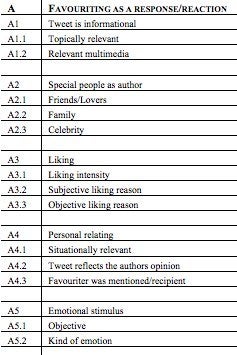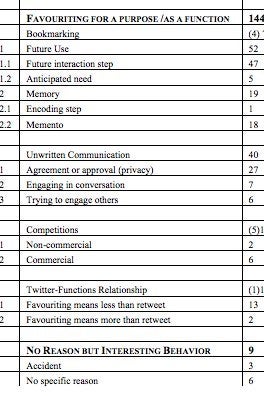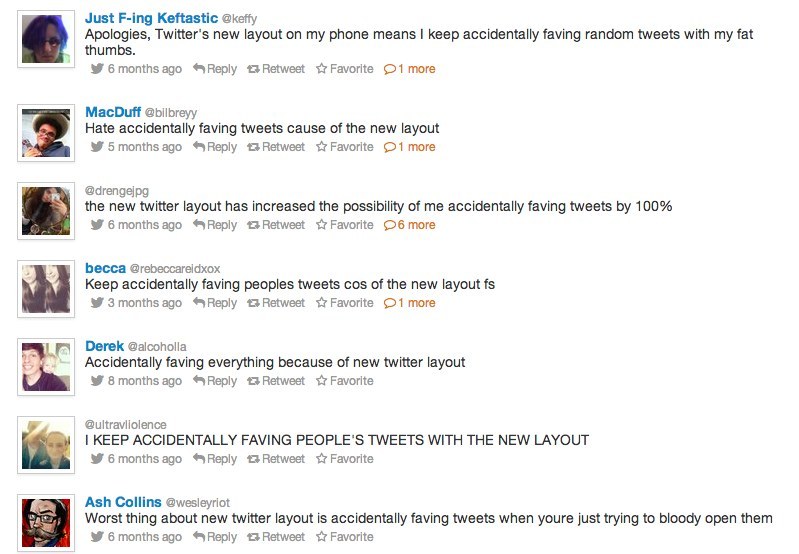Sometime around 2013, Twitter-obsessives became fixated on favoriting. It started with the evolution of Twitter's platform, which shifted to show users their favorites more clearly. As with most of Twitter's standard features, users seemed to co-opt the fav from its original use as a 'Like' button stand-in, assigning any number of meanings to the action.
The fav began its public transformation from a garden variety feature into one of the most complex and cryptic forms of online communication. We started naming our favs. The 'hate fav' was born. So was the 'flirt fav.' And twitter responded, making favorite counts public on its new user profile pages. We saw that some had faved tens of thousands of times! The fav had taken on a life of its own.
It was time for science to intervene and tell us why we fav.
Thanks to a study published by the Association for the Advancement of Artificial Intelligence, this year we now have what amounts to an official taxonomy of faving behaviors. Conducted by Florian Meier and David Elsweiler from the University of Regensburg, Germany and Max L. Wilson from the University of Nottingham after extensive surveys with 606 Twitter users (many long-term users), the study sought to classify the myriad of individual reasons for favoriting a tweet in order to "enhance our understanding of what people want to do with Twitter."
While only 65% of participants were actually aware of the favoriting function, 73.5% of the remaining group were active favoriters and have provided an interesting look at Twitter's most curious feature. It's a by-no-means comprehensive but nonetheless scientific look at the way we fav.


Favoriting As A Response/Reaction
- Liking: This one is first and obvious. "People associate Twitter's favorite button with the Facebook 'Like' button," the study says. But humans are complicated beasts. And there are some important nuances here.
NB: Some study participants indicated they'll only use a fav as a 'Like' if it crosses an intensity threshold. Some reasons respondents included for a 'Like' fav: "If I really like them, I will favorite," "When I like them a lot," "Cause I loved it," "I find the tweet funny or the tweet announces something I like," "I find it amusing or valuable," and finally, "Something that a friend posts that I really like or agree with."
- Tweet is Informational: Think of this as a gratitude fav. One that you might toss out to a news org account or voracious news tweeter. It's not a pity fav, but more of a 'hey sir/madam, nice tweet. That's good info.' It's a way to let them know you're still out there in the abyss, listening. And you like what you see.
- Special People As Author: Let's face it, you're more likely to hurl favs at the special people in your lives. Uncle Tony made a tweet? Yeah, sure, I'll toss him a fav. And then there are celebs — a whole other beast: which is why Lady Gaga can do this and get a cool 8,852 favs:
@
- Tweet Relates Personally To The Favoriter: The study refers to this as an "ego related favorite" or "ego retweet," which is positively brilliant. Respondents found it was "important" or "relevant to me." Some of the best respondent reasons: "Sounds like something I would say about the topic," "messages I believe and felt at the time." Mostly, these favs fall under the broader umbrella: "Because they mentioned me." Special consideration in the study was given to a celeb faving a user's tweet. In the words of one respondent:
"Because it was a reply from Robert Englund and Freddy Kreuger is my favorite horror movie villain of all time.
- Emotional Stimulus: This goes two ways. You fav because a tweet made you feel something or (much more interestingly) you fav because you want to make the tweeter feel something.
Favoriting For A Purpose/As A Function
- Bookmarking: Another obvious case. Along with 'Liking,' bookmarking is the second most cited reason for faving a tweet and an official use case, according to Twitter.
- Unwritten Communication: My former colleague, John Herrman, described this one as the Twitter fist bump. Twitter has indicated previously that it's seen noticeable rises in favs of tweets meant explicitly for the poster. One respondent sums it up in the study: "it's to signal approval of a tweet that I don't want to retweet to my followers." Plain and simple.
- Competitions: On Facebook, this behavior is called 'Like-baiting' and it's quickly being iradicated by Facebook's News Feed algorithms. There's not much to this particular breed of fav. People want to win free stuff.
Retweet or favorite to win your own tote! A winner everyday through 5/9!
- Interaction Hierarchy: This category is oddly worded, but very real. Essentially, for some respondents, the fav appears to be a second-class mode of engagement. Some participants in the study said it was a way to express approval or agreement without sharing, while others said that "motive for favoriting was often that it was not worth a retweet."
While a minority of respondents felt the other way about this, valuing favs over retweets, the respondent data seems to reveal that retweeting may be less about amplifying another user's message and more about the quality and relevancy of that person's feed. Take this respondent, for example example: "I don't retweet them cause I don't think others might find them funny (often because they're offensive/too geeky/too niche)." In others words, while a tweet might be worthy of semi-private encouragement, the tweet or the user may not worthy of a seemingly more public gesture. People care about the integrity of their feeds!
No Reason But Interesting Behavior
- Tweet Was Favorited Accidentally: Besides being my mother's go-to move, the accidental fav is very real and has only picked up steam since Twitter removed reply, retweet, and fav buttons inside tweets during a redesign last year. According to Twitter, retweet and favorite engagement are up 35% since the redesign, in part no doubt because of accidental chubby finger favs.

- No reason: A small, but not insignificant number of respondents gave this answer and there's an interesting nugget buried in here. According to the study, " this response was not uncommon, and often from respondents who otherwise provided good answers...some users have thousands of favorited tweets, and the action is perhaps considered like marking an email as read. Some people seem to have the habit to favorite almost everything in their stream, rather than using the function for a reason."
Then, of course, there is the 'faving to fill the void.' Wired's Mat Honan touched on this in an email that he published on his blog: "I fave things because favoriting is important and society is broken and Twitter is a meaningless and empty way for me to pass the time and avoid any form of introspection that might make me a better or more productive person."
TL;DR: Some favs are best left unexplained.
So! What did we learn? According to the study, the "findings highlight that the favoriting feature is currently being over-utilized for a range of motivations, whilst under-supporting many of them." This is a common complaint for Twitter, which often watches as users find alternative uses for standard features. Indeed, the study finds that user favoriting needs, like bookmarking a tweet for a link, are often unsupported by Twitter's platform.
Ultimately, what the diverse range of motivations behind favoriting may show is that despite Twitter's recent attempts to create an increasingly standardized and top-down user experience, it's still a platform with a massively diverse user base that uses Twitter for many different reasons. And that if Twitter wants to remain an essential part of the conversation, it will take its cues from the way users want to use their technology, and not the other way around.
